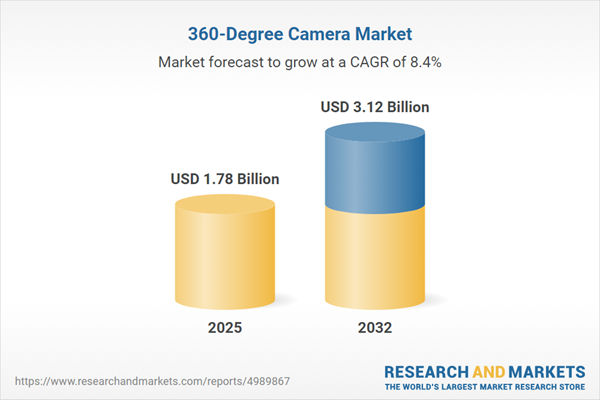Speak directly to the analyst to clarify any post sales queries you may have.
The 360-degree camera market is undergoing rapid evolution as immersive imaging solutions gain traction across commercial enterprises and consumers. Senior leaders navigating this dynamic landscape need focused insights on product innovation, supply strategies, and new use cases that are reshaping operational and competitive priorities.
Market Snapshot: 360-Degree Camera Market Size and Growth
The 360-degree camera market expanded from USD 1.64 billion in 2024 to USD 1.78 billion in 2025 and is projected to continue growing at a CAGR of 8.36%, ultimately reaching USD 3.12 billion by 2032. Sustained momentum reflects advancements in sensor technology and workflow integration, alongside heightened adoption in multiple sectors. Growing demand for immersive imaging drives uptake across event broadcasting, real estate, public safety, and virtual reality settings. Both enterprise and consumer segments fuel this uptake as the need for advanced visual documentation and storytelling becomes more pronounced.
Scope & Segmentation
- Type: Multi-lens systems and single-lens systems cover a broad range of imaging needs, offering flexibility for professional and beginner users alike.
- Distribution Channels: Online platforms such as company websites and e-commerce sites are complemented by brick-and-mortar outlets, including consumer electronics stores and niche camera retailers, ensuring broad accessibility.
- Component: Hardware encompasses lenses, memory, storage, processors, and sensors, while software solutions feature editing, stitching, and streaming capabilities to optimize end-to-end imaging processes.
- Application: Use cases span event broadcasting, personal and professional photography, infrastructure and public security surveillance, traffic monitoring, and virtual reality in areas like education, gaming, real estate marketing, simulation, and employee training.
- End-User: Commercial organizations, defense establishments, industrial facilities, and personal consumers each bring distinct expectations for performance, durability, and technological integration.
- Regions: The Americas, Europe, Middle East & Africa, and Asia-Pacific regions present both mature and emerging opportunities, shaped by evolving local requirements and infrastructure developments. These regional dynamics influence both product features and go-to-market strategies.
Key Takeaways: Strategic Insights for Stakeholders
- 360-degree camera systems are being integrated into broader imaging ecosystems, leveraging artificial intelligence and computational imaging for enhanced capabilities.
- Companies are refining product roadmaps to support digital workflows, prioritizing seamless integration with existing IT infrastructure and intuitive user experiences.
- Consumer expectations for user-friendly features—such as touchscreen controls and mobile connectivity—are shaping product design and accelerating market entry across key segments.
- Manufacturers are boosting R&D investment in proprietary hardware, including lens architectures and processing units, to safeguard intellectual property and lower reliance on third-party suppliers.
- Growth initiatives in Asia-Pacific and the Americas focus on aligning production capabilities with regional policies and technology demand, driving manufacturing and market expansion.
- Strategic partnerships between camera manufacturers, software vendors, and logistics providers support flexible service models and strengthen global and regional supply chains.
Tariff Impact: Navigating Policy Shifts
Recent U.S. tariff changes affecting optical and semiconductor components have led manufacturers to reassess sourcing and assembly strategies. Original equipment manufacturers are exploring nearshoring, renegotiating supplier contracts, and evaluating regional manufacturing to balance costs and reduce risk. Increased emphasis on vertical integration and custom component development aims to safeguard supply chains and sustain competitive differentiation as global trade dynamics shift.
Methodology & Data Sources
This report leverages primary interviews with manufacturers, software firms, and users, supplemented by secondary analysis from published industry sources and regulatory filings. Findings are validated through data triangulation, ensuring reliable market segmentation and actionable opportunity mapping.
Why This 360-Degree Camera Market Report Matters
- Delivers detailed segmentation by system, component, channel, application, and end-user to inform targeted development and investment plans.
- Equips leadership teams with strategic perspectives on evolving technology, policy shifts, and supply impacts that shape partnership and growth decisions.
- Supports risk mitigation and benchmarking by mapping expected effects of trade policy, regulatory environments, and immersive imaging adoption patterns.
Conclusion
Technological advancements, evolving supply chain strategies, and robust end-user engagement present substantial opportunities for organizations in the 360-degree camera market. Leaders applying informed, agile strategies will be well-positioned as the market continues to evolve.
Additional Product Information:
- Purchase of this report includes 1 year online access with quarterly updates.
- This report can be updated on request. Please contact our Customer Experience team using the Ask a Question widget on our website.
Table of Contents
3. Executive Summary
4. Market Overview
7. Cumulative Impact of Artificial Intelligence 2025
List of Figures
Samples

LOADING...
Companies Mentioned
The key companies profiled in this 360-Degree Camera market report include:- GoPro, Inc.
- Shenzhen Arashi Vision Co., Ltd.
- Ricoh Company, Ltd.
- Samsung Electronics Co., Ltd.
- Shanghai Yi Technology Co., Ltd.
- Garmin Ltd.
- Kandao Technology Co., Ltd.
- HumanEyes Technologies Ltd.
- VSN Mobil Industrial Designs, LLC.
- Xiaomi Communications Co., Ltd.
Table Information
| Report Attribute | Details |
|---|---|
| No. of Pages | 192 |
| Published | October 2025 |
| Forecast Period | 2025 - 2032 |
| Estimated Market Value ( USD | $ 1.78 Billion |
| Forecasted Market Value ( USD | $ 3.12 Billion |
| Compound Annual Growth Rate | 8.3% |
| Regions Covered | Global |
| No. of Companies Mentioned | 11 |









